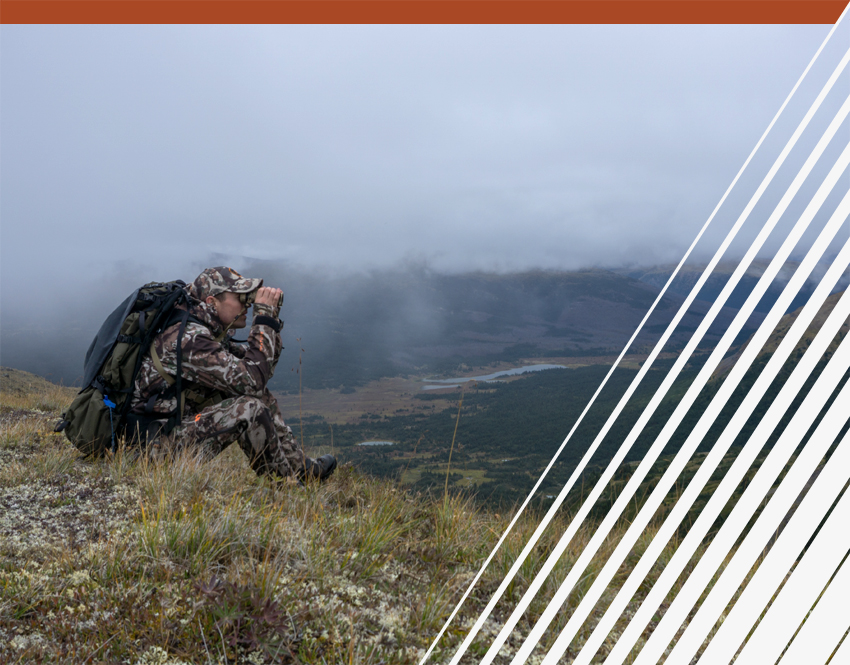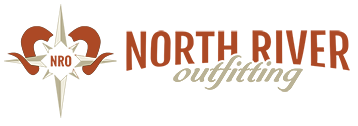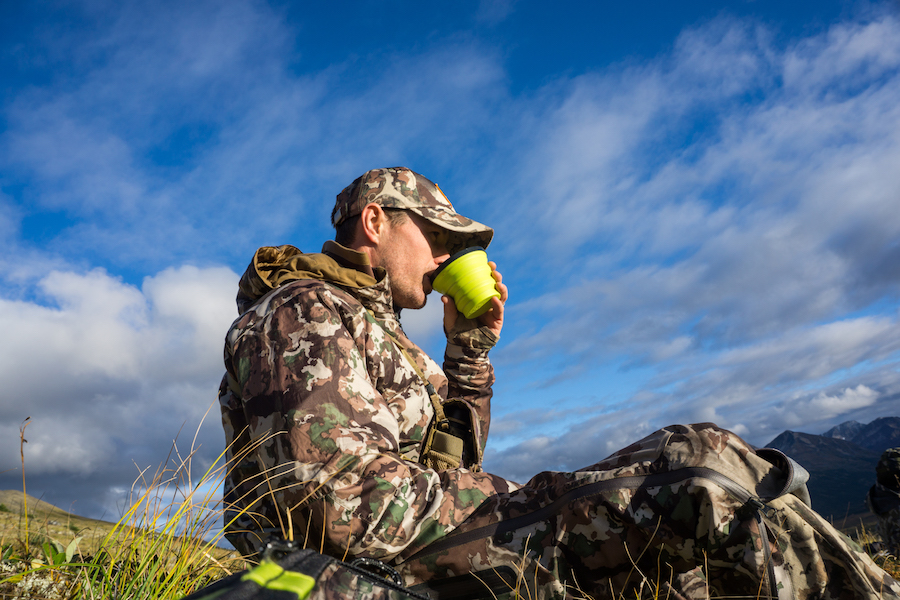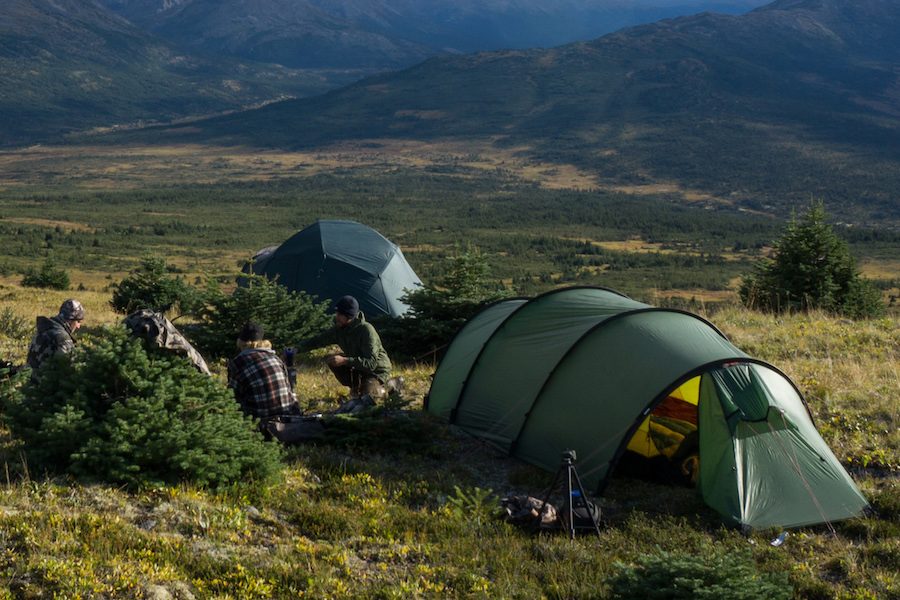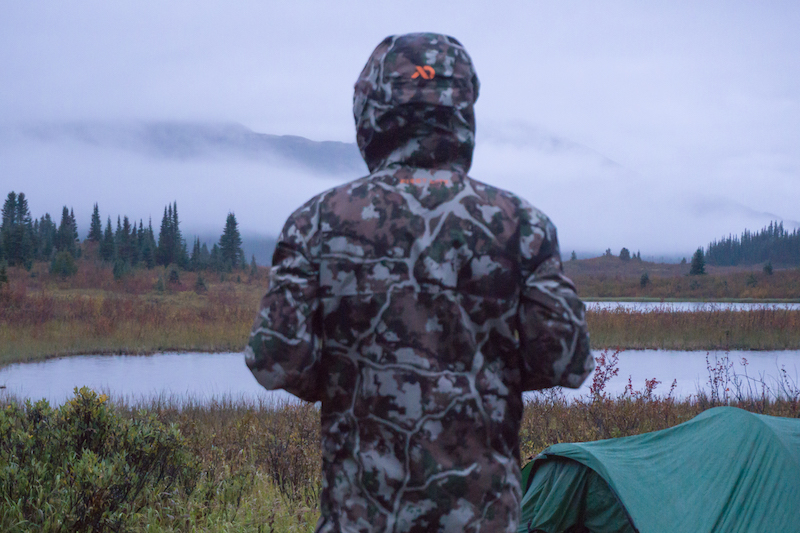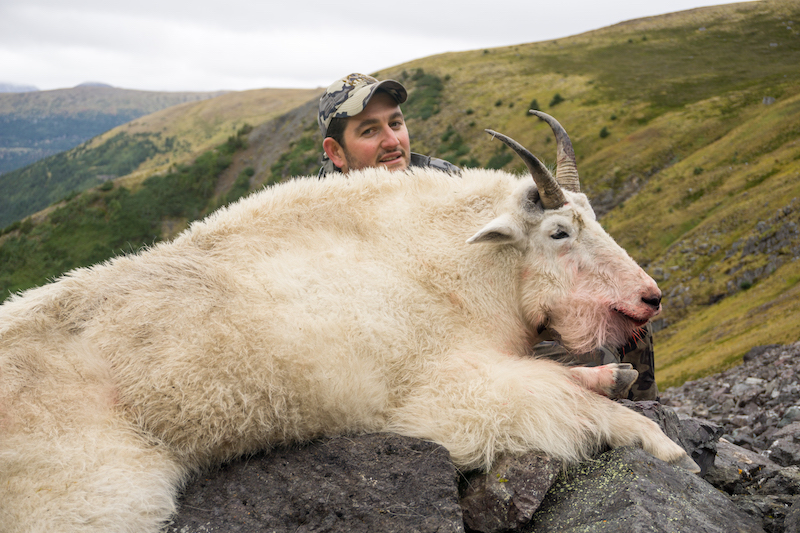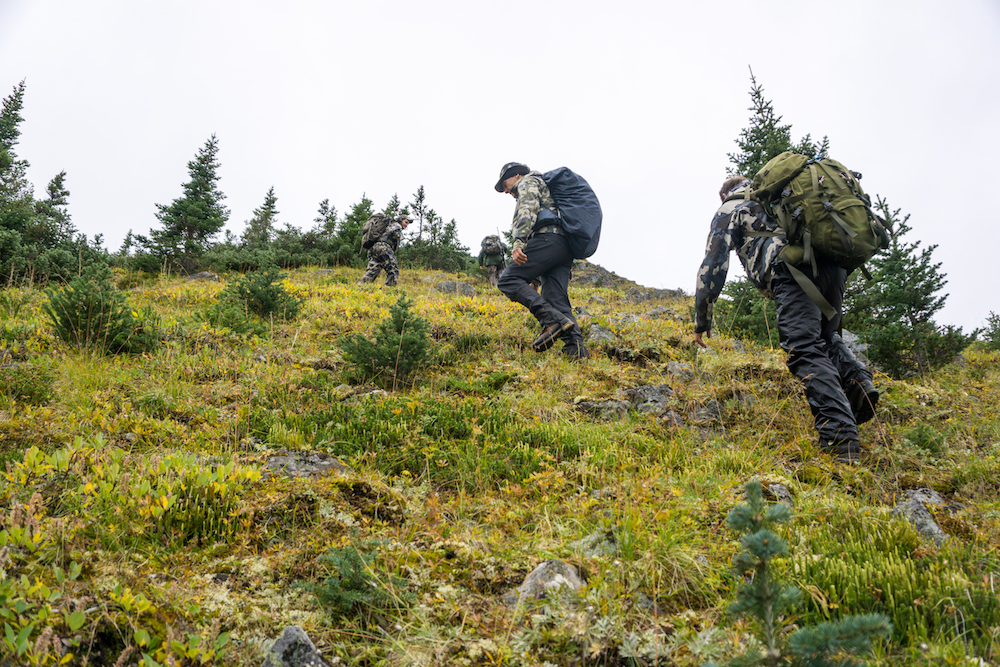Everything You Need for Your Hunt
Read the articles and download a packing list below to make sure you're prepared.
What to expect and pack
Below you'll find a list on what to expect before your hunt, during and after. Along with a detailed list on what gear to use and bring along.
What to expect before: British Columbia
When you have booked your flights to Smithers, British Columbia for your hunt email your dates to North River. After emailing the dates it confirm your arrive then you will have to book a hotel room at the Prestige: Hudson Bay Lodge. The Hudson Bay Lodge in Smithers has a complimentary shuttle to and from all airport terminals. This also will be the shuttle that takes you to the charter company which will fly you to North River Stone’s main lodge. At the main lodge is where you get your license and do a little bit of paperwork. Ensure that your baggage weighs between 40-50 pounds this also includes your rifle or bow. The aircraft that you will be flying on have a limited amount of weight and space so insure that you pack what you need and not what you want. If you choose to drive up please make prior arrangement with us.
Sleeping Systems:
The type of sleeping bags most of us use are mummy style with a full length sleeping pad. It is because we value our sleep, it is one thing that will help you each night as you lay their counting sheep. It is personal preference weather you bring synthetic or down fill bags just make sure it keeps you warm in temperatures ranging from +5 to -15 degrees Celsius or 40 to 5 Fahrenheit. Most of our bags are rated 800 down fill. When you are packing your sleeping bag make sure that it is protected. Having a compression bag that is water proofed or lined with a garbage bag will help with keeping it protected from water and help with space in your backpack. Picking the right sleeping pad is also important. When picking consider weight, length, and cost of the sleeping pad. Most of our guides have full length mats and brands varies. Thermasrest Neo Air, Exped, or Big Agnes, are just a few to look into to see if they fit your needs. As you are getting ready to pack your backpack make sure that you pack a pair of sleeping sock and beanie (toque). Comfort is key when you are alway from your own bed, and it help keep your body heat from escaping as you sleep.
Rifle:
Making sure that you are comfortable with your rifle is key because anything can kill an animal if hit in the right spot. Practice is important, this helps with confidence in your shot. Being comfortable between 200 - 300 yards is quite realistic to shoot when in the mountain. Having your rifle shooting 1.5” to 2” high at 100 yard is ideal. When traveling with your rifle make sure that you use a strong and durable traveling case, airlines can be hard on cases. At the main lodge we strongly recommend that everyone shoot there rifle in to make sure its still accurate after its travels. If you bring a muzzle brake please be considerate for your guides hearing when in the field. Bring gun cleaner and solvents is a good idea as well as packing minimum 1 box of bullets (20 cartridges). Most of all don’t forget a range finder because it is the worst when you are guessing the range out in the field. North River does rent .300 win mag rifles if you find traveling with rifle is a hassle.
Packing List:
When you are packing your bag for your hunt please remember their is a weight restriction when coming into the main lodge of 50 lbs or 22kg. When you are in Smithers, British Columbia you can leave your extra baggage at your hotel, Prestige: Hudson Bay Lodge. They offer a secure and locked room when you are away in the field. We have provided a list of recommended items to bring.
Clothing: For In the Field
- 3-5 pairs of Socks
- 3-5 pairs of Underwear
- 1 pair of base layers: shirt and pant
- 1 pair of mid-layers: Long sleeves shirt or vest, field pants, light jacket
- 1 pair of outer layers: wind breaker jacket, down jacket
- 1 pair of boots Boots
- 1 set of Gaitors
- 1 pair of gloves
- 1 beanie or toque
- 1 Brimmed hat
- Rain gear suit
Pack:
Should be 45-70 lbs including food, water, tent, and weapon. Food will be provided in camp. Try not to bring extras because you will also have an animal to pack out.
- 70 litter or 7000 cubic inches Backpack
- Rainfly
- Sleeping bag
- Sleeping pad
- Knife
- 1 litter Water Bottle
- Ammunition
- Rifle or Bow
- Binoculars and rangefinders
- Lighter and Firestarter
- Head lamp with extra batteries
- Camera with extra battery and memory cards
- Anything else you need for personal self: i.e medication, hygiene, etc.
- Any extra clothing you need: i.e gloves, walking sticks.
Optional items:
- Sunglasses
- Special food you may want - candies, drink crystals, jerkey
- Extra buckle for backpack
- Satellite phone
- Pain Medication if you experience any discomfort
Walking sticks are not required. If you have poor balance or have knee issues we suggest that you invest in a pair. Also walking sticks double as shooting sticks or glassing sticks.
We do offer backpack rentals.
Footwear:
Make sure that you wear boots that fit and are comfortable for your type of foot is important. If you don’t have the right type of boot that fits your foot you will regret being out on your hunt. The boot types we recommend is a leather boot that you are able to waterproof with boot wax or similar boot that is waterproof. Making sure that the side walls of your boots on the outside also has a rock guard so the boot do not get torn up to much by rocks and low bush. If you are someone who gets hotspot often make sure that you pack foot care that works best for you. Others also recommended being extra pair of in soles to help with hot spots. Even if you are someone who never gets hot spots make sure that you invest in some type of foot care that works because you never know what can happen in the field. Please break your boots in before you come on the hunt, see it your feet fit the boots. Boots that we stand behind and recommend are Meindls. There are multiple types of brands of boots to pick from. Make sure that you pick ones that fit your foot and are comfortable because happy feet equals happy you.
Socks systems:
There are so many types and brands out there to pick from. Making sure you find a sock system that works for you and how your feet work. Socks are not cheap, so pick socks that fit your foot. If you are someone who’s feet sweats a lot make sure you pick socks that regulate your feet heat better. For example thinner socks that make your feet breath like a thin nylon/poly blend. If you are someone who’s feet are a cooler than the norm brings socks that keep them warmer. For instant, a wool blends like Smartwool or Wigwam sock. Overall, make sure you know your feet and how they react to temperature changes. We suggest you pack multi pairs of day socks and one pair of sleeping socks. Pack socks according to the time of year you are coming up. Specially for later hunts pack warmer socks that fit the conditions. A pair of socks should last you 2-3 days. A 10 days hunt plan on packing 4 to 6 pairs of socks.
Clothing:
Picking the right clothing is important for you to be comfortable and warm. Bring a -40 degree, three layer wool jacket on a August sheep hunt is not practical not saying you cannot bring it but remember you are going backpacking. Weight is important when picking and choosing the right gear for your hunt. Packing a synthetic poly blend is good because it drys faster then wool products. Generally, lighter wool products does keep you warmer. Having the right layering system ultimately is the best way to prevent you from over heating and keeps you warm and dry. A layering system should look like this, base layer, mid-layer, outer layer. Base layers being your lightest and closest to your body. Mid-layers are are pieces of clothing that can be easily taken off and on so that you can regulate your heat. Outer-layers are your layers that protect you from the elements. All your layers should be easy to handle and remove so you can regulate your body temperature easily.
Don’t forget to pack rain gear. Rain gear is the most important item for clothing. Purchasing the right rain gear will make a world of difference because you want to keep dry. Unless you like being wet. You should purchase gear that works for you but make sure you don’t cheap out on the purchase. If you have any questions about gear purchase please get a hold of us so we can help you before you purchase any gear.
Hunter orange is not required for your hunt with North River Stone.
Training Ideas:
Fitness is important when you are out in the wilderness but your mental fitness is what is going to make or break you. You can be physically strong but if you don’t know how to apply your strengths in the wilderness it is hard to stay positive. Those you should look after your body. Looking after your body is important overall because you only get one. Doing a pre-hunt workout will give you an advantage. At least 3-4 times a week of physical exercise and healthier diet can make a world of difference in your experience in the mountains. Minimum 30-60 minutes each time you train will be beneficial. Make sure that you consider your physical ability and your age before you start consult with a professional physician.
Activities to consider:
- Running or Brisk walking
- Biking: Road or Mountain Biking
- Stationary machines: Treadmill, Stair-master, Bike
- Circuit training
- Martial Arts
- Swimming
Remember the small things to like taking the stairs instead of the elevator or parking a little bit farther then normal.
Backpacking hunt:
Most of are hunts are backpacking based. We suggest that if you have never done a hunt like this take a few months to get your self comfortable with your pack. Start with lower weight, 20- 30 pounds, then build yourself up to 45-65 pounds. If you have backpacked before you have an good idea what to expect. Keep in mind that you will hike your medium weight pack up to 8 hour a day. Of course we will have breaks to glass and rest, remember we are always hunting.
What to expect on a hunt:
You will be hunting in the most remote area in Northern British Columbia. When you have decided to come and hunt with North River Stone you will encounter many situations. One thing we have no control over is the weather. Everyone needs to understand that we have no control over certain events and should work together to enjoy our time together. Now you are a team member and need to work with your Outfitter and Guide to insure that everyone has an great time. When you are with your guide make sure that you communicate with them because they don’t know what you need or like. This is your adventure too, make sure that you communicate with your guide and the Guide will do there best to accommodate you. Overall, your job is to shoot straight when the time comes. We suggest that you practice and are comfortable with your rifle. Only shoot when you comfortable. Missing or wounding in any circumstance is ONLY your fault. Do your best to get ready prior. Our job is to do our best to get you in position when the shot presents itself. So get ready.
Photography:
You never get moments back so bring a camera to capture your moments. Bring a good digital camera with extra batteries and memory cards are a good idea. Moments to think about when taking pictures, at the main lodge, flight pictures, spike camps, scenery and people. We do ask for copies of your pictures after your hunt. Keep in mind most hunters regret that they never brought or taken a picture. If you bring an USB stick or Thumb drive we can get you infield pictures from your guide and packer before you leave.
Taking pictures in the field to consider:
- Clean off all the blood the best you can and stick the tongue back in the mouth of the animal. Depending on the situation ensure that the mouth of the animal is closed.
- Consider the location and position of the animal and ask yourself the following.
- - Is the sun going to effect the exposure?
- - Am I and the animal in a safe location?
- - What is the backdrop?
- Take lots of photo.
- - Single and group shots.
- - Vertical and horizontal
- - Close up and far way
- - Or even in a different position
- - Hand on and off the horn/antler/body
- Consider, do you have everything in the frame. Make sure that you have not cut anything off, faces, horns/antlers, body or legs. Also Make sure that you have removed all backpacks, rags, blood, etc from the fore and background of the pictures.
- Ensure that your pictures are level by having a steady rest
- - tri-pod or backpack can help in creating a steady rest.
What to expect after your hunt:
To meet our time and dates for our scheduled chartered flights we need to get you back to the main lodge, minimum the night before. After arriving back in the main Lodge you can have a hot shower and a home cook meal prepared by Maria. After story time we will need you to fill out a hunting declaration. Make sure that you keep all hunting license and tags because they are your animals export permit. If you choose to take home your animal(s) we will have to arrange an Compulsory Inspection for you in Smithers. If you leave your animal(s) in camp we fly them all out to Smithers and leave it with Daryn Eakin, Northern Wildlife Designs taxidermy. Eakin will get a hold of you about further information about your animal(s).
Before you leave home decide what you would like to do with your horns/antler/hide this will also make the decision easier when you are in the field holding your harvested animal. If you decide to leave earlier then the Scheduled charter flight then the expense is on you and not the Guide-Outfitter. All the Charters have a purpose so we hope you understand this. We will do our best to accommodate you any way we can.
Meat:
British Columbia Law requires us to pack out 4 quarters and loins of harvested animals, unless it is inedible, blood shot, infection or not safe for human consumption. If you choose to take meat home you are allowed 50 lbs on our scheduled charter. Weight is limited due to the allowable weight allowed to use. When taking meat home with you, email us in advance so we can plan around it. As well you have to process the meat in camp if you choose to do so. We have the facilities to process it and make sure that your bring sealable bags to transport the meat. If you want more then the allow able amount then you have to pay extra for all the allowable flight needed to take your meat home. Decide before you are leaving what you would like to do. However, all meat that is not wanted gets used it is either donated to First Nation villages, residents in the northern communities and guides families. We do our best to supply those who are in need of meat for the winter.
Trophy Care and Shipping:
All your capes and horns/antlers get prepared for transportation and storage. All the capes get turned and salted to preserve until they make it to Northern Wildlife Design. Talk with your taxidermy prior to the trip so have an idea on what you would like to see. This helps us with the in-field cuts. Check with your airline if you can take sheep or goat horns home. With larger antlered animals they will have to be split if you choose to take them home on the airplane. If not you can get them shipped to you by Northern Wildlife Designs. Compulsory Inspections is required for all harvested game. If you harvest a wolf you are unable to directly take it home because you need an C.I.T.E.S Permit. Leaving your heads and hides with us to transport they all get tagged with your contact information, hunter and species tag number. Make sure you bring your shipping information for your local taxidermist or any important information that is needed for your animal(s). Also keep all your information that we have provided with you when you are in camp it is what is needed for transportation and your inspection.
Hunt Completion:
The last day of your hunt is a change over day. This is where you arrive back at the main lodge and fly back to Smithers. You then will get picked you up from your in-field camp and bring you back to the main lodge where you can get refreshed and packed. At that time you will have to fill out a hunting report and declaration for your harvested animals. If there are delays due to weather we have an satellite phone to help you re-organize your flights and contact your family. We are here to ensure that we work together to get you back home. Do note that if you decide to leave before your scheduled charter flight then you are responsible for extra charges. These chargers can be as much as $3000.00 for unexpected charters. If you want more than the allowable 50 lbs of meat on the charter, then you have to pay for extra flights to get meat to the place of processing and to destinations. We hope you understand the our pre-scheduled charter flights.
You may download a packing checklist below for a hunt in British Columbia or for an Alberta Whitetail Hunt. Please contact us if you have any questions about what to bring on your hunting adventure.
Please note the gear weight limit for charter flights on a B.C. hunt is 50 pounds, plus your rifle. Please bring soft gun case for transporting your rifle from the hotel to the lodge in B.C.